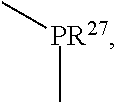Magnesium compound-supported nonmetallocene catalyst and preparation thereof
a nonmetallocene catalyst, magnesium compound technology, applied in the direction of catalyst activation/preparation, physical/chemical process catalysts, chemical/physical processes, etc., can solve the problems of high consumption of methyl aluminoxane, short service life, low or high molecular weight, etc., to achieve easy adjustment of load, increase load, and simple and feasible
- Summary
- Abstract
- Description
- Claims
- Application Information
AI Technical Summary
Benefits of technology
Problems solved by technology
Method used
Image
Examples
example
[0217]The present invention is further illustrated by using the following examples, but the present invention is not confined to same.
[0218]The bulk density of the polymer is measured according to the Chinese Standard GB 1636-79 (unit: g / cm3).
[0219]The respective content of Ti and Mg in the magnesium compound-supported nonmetallocene catalyst is determined by the ICP-AES method.
[0220]The polymerization activity of the catalyst is calculated as follows.
[0221]At the end of the polymerization, the polymer product in the reactor is filtered, dried and weighed for its weight (by mass). Then, the polymerization activity of the catalyst is expressed by a value obtained by dividing the weight of the polymer product by the amount (by mass) of the catalyst used in the polymerization (unit: kg polymer per g Cat).
[0222]The molecular distribution of the polymer is determined by the GPC model V2000 gel permeation chromatographer (WATERS Co., USA), using o-trichloro benzene as the solvent, and at ...
example i-1
[0223]Anhydrous magnesium chloride was used as the magnesium compound, and TiCl4 was used as the chemical treating agent.
[0224]5 g of the anhydrous magnesium chloride was weighted, and 25 ml hexane was added thereto as the solvent for preparing the contact resultant so as to have the magnesium chloride dispersed therein. Then, TiCl4 was dropwise added thereto over a period of 30 minutes under stirring, and was reacted for 4 hours at 60. The resultant was then filtered, washed by hexane for 3 times (25 ml per time), and vacuum-dried, so as to obtain the contact resultant.
[0225]In this step, the ratio by molar of TiCl4 to the magnesium compound was 1:2.
[0226]A nonmetallocene ligand of the structure
was dissolved in hexane (as the solvent for dissolving the nonmetallocene ligand), then the contact resultant was added thereto under stirring, and the reaction continued for 4 hours. After filtrated, washed by hexane for 2 times (25 ml per time), and dried at 25° C. for 6 hours, a magnesium...
example i-1-1
[0229]Substantially the same as the Example I-1, except for the following changes:
[0230]The magnesium compound was changed to magnesium bromide, the chemical treating agent was changed to TiBr4, and the ratio by molar of TiBr4 to the magnesium compound was 1:4.5.
[0231]The solvent for preparing the contact resultant was changed to decane.
[0232]The nonmetallocene ligand was changed to
and the solvent for dissolving the nonmetallocene ligand was changed to decane.
[0233]In this example, the concentration by mass of the nonmetallocene ligand was 50 g / L, and the ratio by mass of the nonmetallocene ligand to the contact resultant was 0.22:1.
PUM
| Property | Measurement | Unit |
|---|---|---|
| Density | aaaaa | aaaaa |
| Volume | aaaaa | aaaaa |
| Flexibility | aaaaa | aaaaa |
Abstract
Description
Claims
Application Information
 Login to View More
Login to View More - R&D
- Intellectual Property
- Life Sciences
- Materials
- Tech Scout
- Unparalleled Data Quality
- Higher Quality Content
- 60% Fewer Hallucinations
Browse by: Latest US Patents, China's latest patents, Technical Efficacy Thesaurus, Application Domain, Technology Topic, Popular Technical Reports.
© 2025 PatSnap. All rights reserved.Legal|Privacy policy|Modern Slavery Act Transparency Statement|Sitemap|About US| Contact US: help@patsnap.com



